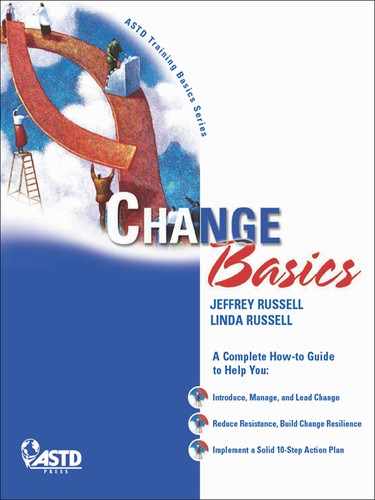References
American Psychological Association. (2004). “The Road to Resilience.” Washington, D.C.: American Psychological Association. http://helping.apa.org/featuredtopics/feature.php?id=6.
Armenakis, A.A., S.G. Harris, and K.W. Mossholder. (1993). “Creating Readiness for Organizational Change.” Human Relations, 46(6): 681–703.
Bernard, B. (1991). Fostering Resiliency in Kids: Protective Factors in the Family, School, and Community. Portland, OR: Northwest Regional Education Laboratory.
Bridges, W. (1991). Managing Transitions. Reading, MA: Addison-Wesley Publishing Company.
Brooks, R., and S. Goldstein. (2003). The Power of Resilience: Achieving Balance, Confidence, and Personal Strength in Your Life. New York: McGraw-Hill.
Cairns, R.B., and B.D. Cairns. (1995). Lifelines and Risks: Pathways of Youth in Our Time. Cambridge, England: Cambridge University Press.
Compact Oxford English Dictionary (1991). New York: Oxford University Press USA.
Conner, D.R. (1992). Managing at the Speed of Change. New York: Random House.
Cooperrider, D., D. Whitney, and J.M. Stavros. (2003). Appreciative Inquiry Handbook. Bedford Heights, OH, and San Francisco, CA: Lakeshore Communications and Berrett-Koehler.
Dalai Lama XIV. (1998). The Four Noble Truths. London, England: Thorsons.
Dunham, R. (1984). Organizational Behavior: People and Processes Management. Homewood, IL: Richard D. Irwin.
Frankl, V.E. (1997). Man's Search for Meaning. New York: Washington Square Press, Pocket Books, and Simon & Schuster.
Garmezy, N. (1991). “Resiliency and Vulnerability to Adverse Developmental Outcomes Associated With Poverty.” American Behavioral Scientist, 34(4): 416–430.
Goleman, D. (2004, January). “What Makes a Leader (HBR Classic).” Harvard Business Review, 82–91.
Goleman, D., R. Boyatizis, and A. McKee. (2002). Primal Leadership: Learning to Lead with Emotional Intelligence. Boston: Harvard Business School Press.
Hammer, M., and J. Champy. (1993). Reengineering the Corporation. New York: HarperCollins.
Hultman, K. (1979). Path of Least Resistance: Preparing Employees for Change. Austin, TX: Learning Concepts.
Hultman, K. (1998). Making Change Irresistible: Overcoming Resistance to Change in Your Organization. Palo Alto, CA: Davies-Black Publishing.
Kepner-Tregoe. (1994). House Divided: Views on Change from Top Management and Their Employees. Princeton, NJ: Author.
Kotter, J.P., and L.A. Schlesinger. (1979). “Choosing Strategies for Change.” Harvard Business Review, 79(3).
Kübler-Ross, E. (1997). On Death and Dying (reprint edition). New York: Simon & Schuster.
Kurzweil, R. (2001). “Law of Accelerating Returns.” www.KurzweilAI.net.
Lawrence, P.R. (1969). “How to Deal With Resistance to Change.” Harvard Business Review, 69(1).
Lewin, K. (1999, December 1). “Kurt Lewin: Change Management and Group Dynamics.” Thinkers. London, England: Chartered Management Institute.
Lincoln, A., and R.P. Basler. (1953). Collected Works of Abraham Lincoln, volume 5. Piscataway, NJ: Rutgers University Press.
Manchester, W. (1983). The Last Lion: Winston Spenser Churchill, Visions of Glory (1st edition). Boston: Little, Brown and Company.
Mandela, N. (1994). Long Walk to Freedom. Boston: Back Bay Books.
Maslow, A.H. (1999). Toward a Psychology of Being (3rd edition). New York: John Wiley & Sons.
Maurer, R. (1996, June). “Using Resistance to Build Support for Change,” Journal for Quality and Participation. http://www.findarticles.com/p/articles/mi_qa3616/is_199606/ai_n8735568.
O'Neil, J. (1993). The Paradox of Success: When Winning at Work Means Losing at Life. New York: Putnam and Sons.
Oestreich, D. (2001). Our Star. Redmond, WA: Author. http://unfoldingleadership.com/page7/files/ourstar.pdf.
Reivich, K., and A. Shatté. (2003). The Resilience Factor: Seven Essential Skills for Overcoming Life's Inevitable Obstacles. New York: Broadway Books.
Rotter, J.B. (1966). “Generalized Expectancies for Internal Versus External Control of Reinforcement.” Psychological Monographs, 80(1, whole no. 609).
Russell, J., and L. Russell. (1998). Managing Change. Dubuque, IA: Kendall/Hunt Publishing Company for Credit Union National Association.
Russell, J., and L. Russell. (2003). Leading Change Training. Alexandria, VA: ASTD Press.
Rutter, M. (1977). “Protective Factors in Children's Responses to Stress and Disadvantage.” In: M.W. Kent & J.E. Rolf (editors), Primary Prevention in Psychopathology, volume III: Social Competence in Children. Hanover, NH: University Press of New England.
Salk, J. (1973). Survival of the Wisest. New York: Harper & Row Publishers.
Schein, E. (1999). The Corporate Culture Survival Guide. San Francisco: Jossey-Bass.
Schein, E. (2001, July). Lecture at the Cape Cod Institute. Eastham, MA.
Schein, E. (2004). Organizational Culture and Leadership (3rd edition). San Francisco: Jossey-Bass.
Scott, C. (1995). Presentation at the 1995 Hunter Conference, Madison Area Quality Improvement Network. Madison, WI.
Senge, P. (1990). The Fifth Discipline: The Art and Practice of the Learning Organization. New York: Doubleday.
Skinner, B.F. (1938). The Behavior of Organisms: An Experimental Analysis. New York: D. Appleton-Century Company.
Solomon, R., and F. Flores. (2001). Building Trust in Business, Politics, Relationships, and Life. New York: Oxford University Press.
Spitzer, T.Q., Jr. (1996). Managing the Human Side of Change. Princeton, NJ: Kepner-Tregoe. http://www.quality.org/tqmbbs/prin-pract/peowise.txt.
Strebel, P. (1996). “Why Do Employees Resist Change?” Harvard Business Review, 96(5): 86–92.
U.S. Bureau of Labor Statistics. http://www.bls.gov/.
Webster's Encyclopedic Unabridged Dictionary of the English Language. (1996). New York: Random House.
Werner, E., and R. Smith. (2001). Journeys From Childhood to Midlife: Risk, Resilience, and Recovery. Ithaca: NY: Cornell University Press.
